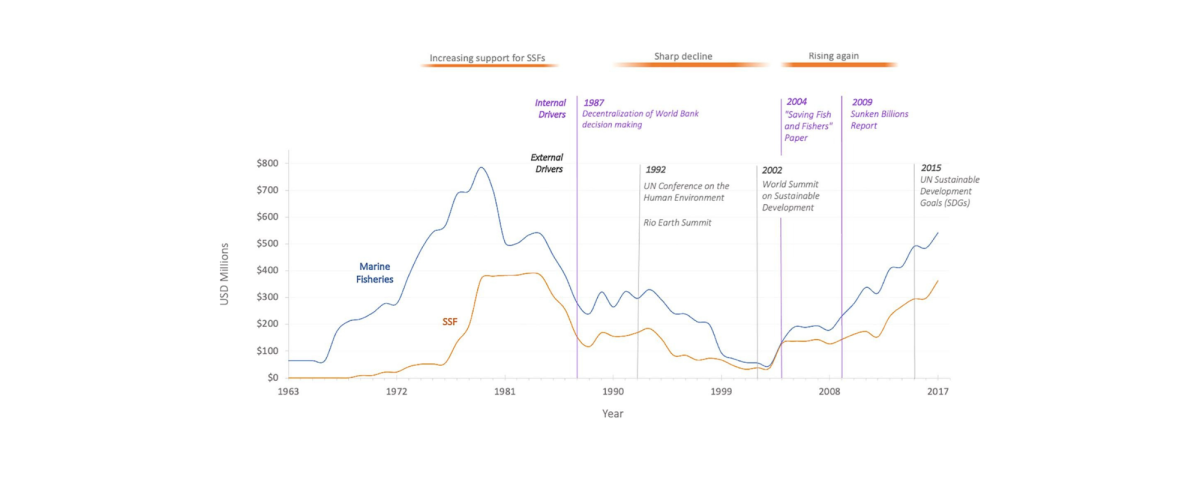By John Virdin and Xavier Basurto
As the International Year of Artisanal Fisheries and Aquaculture approaches in 2022, it might be useful to look at the landscape of development aid to small-scale fisheries. In that context, we wanted to highlight a recent study completed with colleagues, aiming to understand the role of the World Bank in small-scale fisheries – one of the largest providers of aid to fisheries.
This study, led by Jill Hamilton, Xavier Basurto and Hillary Smith, asked how World Bank funding for marine fisheries broadly, and marine small-scale fisheries (SSF) more specifically, has changed over the last 50 years and why. Though time-consuming, the World Bank’s website includes a searchable database of all projects the organization has funded, allowing the team to build a database of fisheries projects over time, and dig into the details to examine what portions funded small-scale fisheries explicitly.
Interestingly, the total funding levels from the World Bank for marine fisheries, and SSF specifically, appears to have occurred in distinct eras, related to a focus on fisheries development (i.e., mainly ports, boats and other fishing means of production) largely in the 1970s to mid-1980s, followed by a sharp decline in funding until the mid-2000s, after which it picks up again until the present.

Figure 1. World Bank funding in USD millions targeted to support marine fisheries and the subsector of small-scale fisheries over time (1963-2017) as real dollars (November 2018 dollars). Key internal (purple) and external (gray) drivers of World Bank funding targeted to support marine fisheries over time (not exhaustive). Aid amounts are represented as total active funding over time, rather than annual new allocations. Source: Hamilton et al. (2021).
The focus of projects in the current era since the early 2000s has largely shifted from single economic goals to governance of fisheries and multi-dimensional environmental goals (e.g., poverty alleviation, food security, etc.,). The goal of the study was also to explain what led to these paradigm shift in development aid. We found that no one single factor explained the internal and external drivers of funding trends – both internal drivers such as staff changes and decentralization and recentralization of decision-making played a role, as well as external driver such as rising interest in fisheries from both donor and recipient governments, and key global environmental summits, among other related social movements.
The focus of the study centered on identifying trends in World Bank aid to SSF, and explain why those trends occurred. Identifying the impact of this aid was beyond the scope of the study. Measuring the impact of policies or projects is always challenging, but particularly difficult over the relatively long time periods of some projects supporting SSF, and in the case of governance-centric outcomes. Field-based empirical studies are needed to assess the impact of this aid at the level of fishing communities.
Going forward, designing monitoring and evaluation programs of governance outcomes in SSFs that help track contributions toward internationally-agreed principles in the SSF Guidelines and targets such as securing access for SSF in SDG 14, must be a priority if stakeholders and researchers are to understand the impact of aid funding for small-scale fisheries. In particular, this should include diversifying how we think about impact and the range of stakeholders involved in designing these monitoring and evaluation programs, to ensure that success is not measured in terms imposed by a relative few or small elite.
Given the scale of involvement in SSF by the World Bank, and the emergent interest among other global actors such as environmental philanthropies and non-governmental organizations, coordination around a shared framework for such monitoring and evaluation could be helpful as part of a global agenda to support implementation of the SSF Guidelines.
Our hope is that the upcoming Illuminating Hidden Harvests study, led by FAO and WorldFish, can help contribute to this type of monitoring framework, to support more harmonized and widespread evaluation of the impact of development aid on governance in SSFs.
This article is part of the SSF Highlights series of articles published regularly to the SSF Hub. To read previous SSF Highlights, follow this link.
